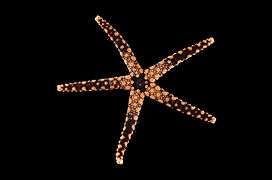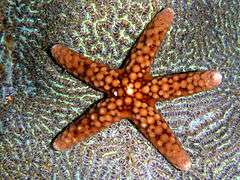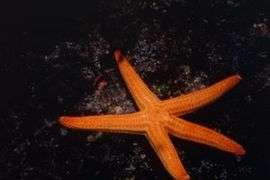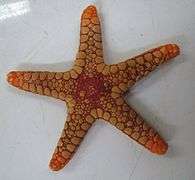Ophidiasteridae
| Ophiodiasteridae | |
|---|---|
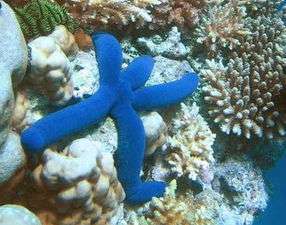 | |
| Linckia laevigata | |
 | |
| Gomophia egyptiaca at the Red Sea | |
| Scientific classification | |
| Kingdom: | Animalia |
| Subkingdom: | Eumetazoa |
| Phylum: | Echinodermata |
| Class: | Asteroidea |
| Order: | Valvatida |
| Family: | Ophidiasteridae |
| Genera | |
|
See Text. | |
The Ophidiasteridae (Greek ophidia, Οφιδια, "of snakes", diminutive form) are a family of sea stars with about 30 genera. Occurring both in the Indo-Pacific and Atlantic Oceans, ophidiasterids are greatest in diversity in the Indo-Pacific. Many of the genera in this family exhibit brilliant colors and patterns, which sometimes can be attributed to aposematism and crypsis to protect themselves from predators. Some ophidiasterids possess remarkable powers of regeneration, enabling them to either reproduce asexually or to survive serious damage made by predators or forces of nature (an example for this is the genus Linckia). Some species belonging to Linckia,[1] Ophidiaster [2] and Phataria [3] shed single arms that regenerate the disc and the remaining rays to form a complete individual. Some of these also reproduce asexually by parthenogenesis.[4]
The name of the family is taken from the genus Ophidiaster, whose limbs are slender, semitubular and serpentine.
Systematics
These genera are accepted in the World Register of Marine Species:[5]
- Andora A.M. Clark, 1967
- Austrofromia H.L. Clark, 1921
- Bunaster Doderlein, 1896
- Celerina A.M. Clark, 1967
- Certonardoa H.L. Clark, 1921
- Cistina Gray, 1840
- Copidaster A.H.Clark, 1948
- Dactylosaster Gray, 1840
- Devania Marsh, 1974
- Dissogenes Fisher, 1913
- Drachmaster Downey, 1970
- Ferdina Gray, 1840
- Gomophia Gray, 1840
- Hacelia Gray, 1840
- Heteronardoa Hayashi, 1973
- Leiaster Peters, 1852
- Linckia Nardo, 1834
- Narcissia Gray, 1840
- Nardoa Gray, 1840
- Oneria Rowe, 1981
- Ophidiaster L. Agassiz, 1836
- Paraferdina James, 1976
- Pharia Gray, 1840
- Phataria Gray, 1840
- Plenardoa H.L. Clark, 1921
- Pseudophidiaster H.L. Clark, 1916
- Sinoferdina Liao, 1982
- Tamaria Gray, 1840
External links
References
- ↑ McAlary, Florence A. "Population Structure and Reproduction of the Fissiparous Seastar, Linckia columbiae Gray, on Santa Catalina Island, California" (Article). Retrieved 2011-07-14.
- ↑ See last paragraph in review above AnalysisHotchkiss, Frederick H. C. (2000-06-01). "On the Number of Rays in Starfish" (PDF). American Zoologist 40 (3): 340–354. doi:10.1093/icb/40.3.340. Retrieved 2011-07-14.
- ↑ Monks, Sarah P. (1904-04-01). "Variability and Autotomy of Phataria" (PDF). Proceedings of the Academy of Natural Sciences of Philadelphia 56 (2): 596–600. ISSN 0097-3157. JSTOR 4063000. Retrieved 2011-07-15.
- ↑ Yamaguchi, M.; J. S. Lucas (1984). "Natural parthenogenesis, larval and juvenile development, and geographical distribution of the coral reef asteroid Ophidiaster granifer". Marine Biology 83 (1): 33–42. doi:10.1007/BF00393083. ISSN 0025-3162. Retrieved 2011-07-24.
- ↑ Ophidiasteridae World Register of Marine Species. Retrieved 2011-10-17.
